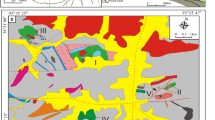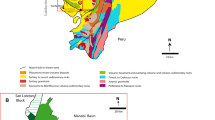Abstract
The Ashin ophiolite is situated in the western part of Central Iran and presents two stages of Jurassic and Cretaceous spreading. The Ashin ophiolite represents fragments of the Neo-Tethys oceanic lithosphere. Plagiogranite intrusions of this ophiolite have good exposures. Plagiogranites of Cretaceous are more fresh than the metamorphosed samples of Jurassic. The main minerals of plagiogranites from the Ashin ophiolite are plagioclase, quartz and amphibole. Plagiogranites of the Jurassic have tholeitic nature with higher amounts of amphibole, \({\text{F}}{{{\text{e}}}_{2}}{\text{O}}_{3}^{*},\) TiO2, Co and lower values of Mg#, Th and Sr than the Cretaceous calc-alkaline plagiogranites. The chondrite-normalized REE patterns of these plagiogranites are characterized by higher values of REEs and negative Eu anomalies for the Jurassic samples and low values of REEs and positive Eu anomalies for the Cretaceous ones. Very low values of HREEs in the Cretaceous plagiogranites indicates a non-peridotitic source rock. We suggest that the Jurassic plagiogranites are formed by fractional crystallization of a low-K tholeitic magma; and the adakitic Cretaceous plagiogranites are formed by partial melting of an amphibolite in the subducting slab. Geochemical criteria of the Ashin plagiogranites indicate changing the Ashin ophiolite tectonic setting from a mid-ocean ridge system in the Jurassic to a supra-subduction zone in the Cretaceous.








Similar content being viewed by others
REFERENCES
F. Barker, “Trondhjemite: Definition, environment and hypotheses of origin,” in Trondhjemites, Dacites and Related Rocks, Ed. by F. Barker (Elsevier, Amsterdam, 1979), pp.1‒12.
J. S. Beard and G. E. Lofgren, “Dehydration melting and water-saturated melting of basaltic and andesitic greenstones and amphibolites at 1, 3, and 6.9 kb,” J. Petrol. 32, 365‒401 (1991).
R. G. Coleman, Ophiolites – Ancient Lithosphere? (Springer, New York, 1977).
R. G. Coleman and M. M. Donato, “Oceanic plagiogranite revisited,” in Trondhjemites, Dacites and Related Rocks, Ed. By F. Barker (Elsevier, Amsterdam, Netherlands, 1979), pp. 149‒168.
R. G. Coleman and Z. E. Peterman, “Oceanic plagiogranite,” J. Geophys. Res. 80, 1099‒1108 (1975).
W. A. Deer, R. A. Howie, and J. Zussman, An Introduction to the Rock-Forming Minerals (Longman, London, 1991).
M. J. Defant and M. S. Drummond, “Derivation of some modern arc magmas by melting of young subducted lithosphere,” Nature 347, 662‒665 (1990).
S. Dixon and M. J. Rutherford, “Plagiogranites as late stage immiscible liquids in ophiolite and mid-ocean ridge suites: An experimental study,” Earth Planet. Sci. Lett. 45, 45‒60 (1979).
M. S. Drummond and M. J. Defant, “A model for trondhjemite-tonalite-dacite genesis and crustal growth via slab melting: Archean to modern comparisons,” J. Geophys. Res., [Solid Earth Planets] 95, 21503‒21521 (1990).
M. S. Drummond, M. J. Defant, and P. K. Kepezhinskas, “Petrogenesis of slab-derived trondhjemite–tonalite–dacite/adakite magmas,” Trans. R. Soc. Edinburgh: Earth Sci. 87, 205‒215 (1996).
P. A. Floyd, M. K. Yaliniz, and M. C. Goncuoglu, “Geochemistry and petrogenesis of intrusive and extrusive ophiolitic plagiogranites, Central Anatolian Crystalline Complex, Turkey,” Lithos 42, 225‒241 (1998).
S. Foley, M. Tiepolo, and R. Vannucci, “Growth of early continental crust controlled by melting of amphibolite in subduction zones,” Nature 417, 837‒840 (2002).
C. B. Grimes, T. Ushikubo, R. Kozdon, and J. W. Valley, “Perspectives on the origin of plagiogranite in ophiolites from oxygen isotopes in zircon,” Lithos 179, 48‒66 (2013).
A. R. Hastie, A. C. Kerr, J. A. Pearce, and S. F. Mitchell, “Classification of altered volcanic island rocks using immobile trace elements, development of the Th–Co discrimination diagram,” J. Petrol. 48, 2341‒2357 (2007).
T. N. Irvine and W. R. A. Baragar, “A guide to the chemical classification of the common volcanic rocks,” Can. J. Earth Sci. 8, 523‒548 (1971).
J. Koepke, J. Berndt, S. T. Feig, and F. Holtz, “The formation of SiO2-rich melts within the deep oceanic crust by hydrous partial melting of gabbros,” Contrib. Mineral. Petrol. 153, 67‒84 (2007).
B. E. Leake, A. R. Woolley, C. E. S. Arps, W. D. Birch, M. C. Gilbert, J. D. Grice, F. C. Hawthorne, A. Kato, H. J. Kisch, V. G. Krivovichec, K. Linthout, J. Laird, J. Mandarino, W. V. Maresch, E. H. Nickel, et al., “Nomenclature of amphiboles; Report of the Subcommittee on amphiboles of the International Mineralogical Association Commission on New Minerals and Mineral Names,” Eur. J. Mineral. 9, 623‒651 (1997).
R. W. Le Maitre, Igneous Rocks: A Classification and Glossary of Terms, 2nd ed., (Cambridge Univ. Press, Cambridge, 2002).
M. V. Luchitskaya, O. L. Morozov, and S. A. Palandzhyan, “Plagiogranite magmatism in the Mesozoic island-arc structure of the Pekulney Ridge, Chukotka Peninsula, NE Russia,” Lithos 79, 251‒269 (2005).
M. V. Luchitskaya, “Plagiogranites of the Kuyul ophiolite massif (northeastern Kamchatka, Koryak Upland),” Ofioliti 21, 131‒138 (1996).
A. Magganas, “Plagiogranitic rocks of Evros Ophiolite, NE Greece,” Bull. Geol. Soc. Greece, 40, 884‒898 (2007).
P. D. Maniar and P. M. Piccoli, “Tectonic discrimination of granitoids,” Bull. Geol. Soc. Am. 101, 635‒643 (1989).
H. Martin, R. H. Smithies, R. Rapp, J. F. Moyen, and D. Champion, “An overview of adakite, tonalite-trondhjemite-granodiorite (TTG), and sanukitoid: Relationships and some implications for crustal evolution,” Lithos 79, 1‒24 (2005).
W. F. McDonough and S. S. Sun, “The composition of the Earth,” Chem. Geol. 120, 223‒253 (1995).
E. A. K. Middlemost, “Iron oxidation ratios, norms and the classification of volcanic rocks,” Chem. Geol. 77, 19‒26 (1989).
N. Nosouhian, G. Torabi, and S. Arai, “Late Cretaceous dacitic dyke swarm from Central Iran, a trace for amphibolite melting in a subduction zone,” Geotectonics 50, 295‒312 (2016).
J. T. O’Connor, “A classification for quartz-rich igneous rock based upon feldspar ratios,” in Geological Survey Research 1965, Chapter B, Vol. 525B of U.S. Geol. Surv., Prof. Pap. (U.S. Gov. Print Office, Washington, DC, 1965), pp. B79‒B84.
J. A. Pearce, N. B. W. Harris, and A. G. Tindle, “Trace element discrimination diagrams for the tectonic interpretation of granitic rocks,” J. Petrol. 25, 956‒983 (1984).
H. R. Rollinson, “Ophiolitic trondhjemites: an analogue for the formation of Hadean felsic ‘crust’,” Terra Nova 20, 364‒369 (2008).
H. R. Rollinson, “New models for the genesis of plagiogranites in the Oman ophiolite,” Lithos 112, 603‒614 (2009).
T. Rushmer, “Partial melting of two amphibolites: Contrasting experimental results under fluid-absent conditions,” Contrib. Mineral. Petrol. 107, 41‒59 (1991).
M. Sharkovski, M. Susov, B. Krivyakin, L. Morozov, V. Kiristaev, and E. Romanko, Geology of the Anarak area (Central Iran): Report TE/No.19 (Geol. Surv. Iran, 1984).
J. W. Shervais, “Tonalites, trondhjemites, and diorites of the Elder Creek ophiolite, California: Low-pressure slab melting and reaction with the mantle wedge,” in Ophiolites, Arcs, and Batholiths: A Tribute to Cliff Hopson, Vol. 438 of Geol. Soc. Am., Spec. Pap., Ed. by J. E. Wright and J. W. Shervais (2008), pp. 113‒132.
N. Shirdashtzadeh, G. Torabi, and S. Arai, “Metamorphism and metasomatism in the Jurassic Nain ophiolithic mélange, Central Iran,” Neues Jahrb. Geol. Palaeontol., Abh. 255, 255‒275 (2009).
N. Shirdashtzadeh, G. Torabi, and S. Arai, “Two Mesozoic oceanic phases recorded in the basic and metabasic rocks of the Nain and Ashin-Zavar ophiolitic mélanges (Isfahan province, Central Iran),” Ofioliti 36, 191‒205 (2011).
S. S. Sun and W. F. McDonough, “Chemical and isotopic systematics of oceanic basalts: implications for mantle composition and processes,” in Magmatism in Ocean Basins, Vol. 42 of Geol. Soc. London, Spec. Publ., Ed. by A. D. Saunders and M. J. Norry, (1989), pp. 313‒346.
G. Torabi, “Late Permian post-ophiolitic trondhjemites from Central Iran: a mark of subduction role in growth of Paleozoic continental crust,” Island Arc 21, 215‒229 (2012).
G. Torabi, “Middle Eocene volcanic shoshonites from western margin of Central-East Iranian Microcontinent (CEIM), a mark of previously subducted CEIM-confining oceanic crust,” Petrology 19, 675‒689 (2011).
G. Torabi, “Early Oligocene alkaline lamprophyric dykes from the Jandaq area (Isfahan Province, Central Iran): An evidence of CEIM confining oceanic crust subduction,” Island Arc 19, 277‒292 (2010).
G. Torabi, S. Arai, and H. Abbasi, “Eocene continental dyke swarm from Central Iran (Khur area),” Petrology 22, 1‒16 (2014).
G. Torabi, N. Shirdashtzadeh, S. Arai, and J. Koepke, “Paleozoic and Mesozoic ophiolites of Central Iran: Amphibolites from Jandaq, Posht-e-Badam, Nain and Ashin ophiolites,” Neues Jahrb. Geol. Palaeontol., Abh. 262, 227‒240 (2011).
T. Üner, Ç. Üner, Y. Özdemir, and R. Arat, “Geochemistry and origin of plagiogranites from the Eldivan Ophiolite, Çankırı (Central Anatolia, Turkey),” Geol. Carpathica 65, 195‒205 (2014).
D. L. Whitney and B. W. Evans, “Abbreviations for names of rock-forming minerals,” Am. Mineral. 95, 185‒187 (2010).
P. J. Wyllie and M. B. Wolf, “Amphibolite-dehydration melting: sorting out the solidus,” in Magmatic Processes and Plate Tectonics, Vol. 76 of Geol. Soc. London, Spec. Publ., Ed. by Ed. by H. M. Pritchard, T. Alabaster, N. B. W. Harris, and C. R. Neary (London, 1993), pp. 405‒416.
M. B. Wolf and P. J. Wyllie, “Dehydration-melting of amphibolite at 10 kbar: Effects of temperature and time,” Contrib. Mineral. Petrol. 115, 369‒383 (1994).
ACKNOWLEDGMENTS
The authors thank the University of Isfahan (Iran) and Kanazawa University (Japan) for financial support. This paper has greatly benefited from the helpful and constructive comments by reviewers Prof. Dr. Marina V. Luchitskaya and Prof. Dr. Andrey A. Shchipansky.
Author information
Authors and Affiliations
Corresponding author
Additional information
Reviewers: M.V. Luchitskaya and A.A. Shchipansky
The article is published in the original.
Rights and permissions
About this article
Cite this article
Torabi, G., Morishita, T. & Arai, S. Two Types of Plagiogranite from Mesozoic Ashin Ophiolite (Central Iran): a Mark of Tectonic Setting Change from Jurassic to Cretaceous. Geotecton. 53, 110–124 (2019). https://doi.org/10.1134/S0016852119010084
Received:
Revised:
Accepted:
Published:
Issue Date:
DOI: https://doi.org/10.1134/S0016852119010084




